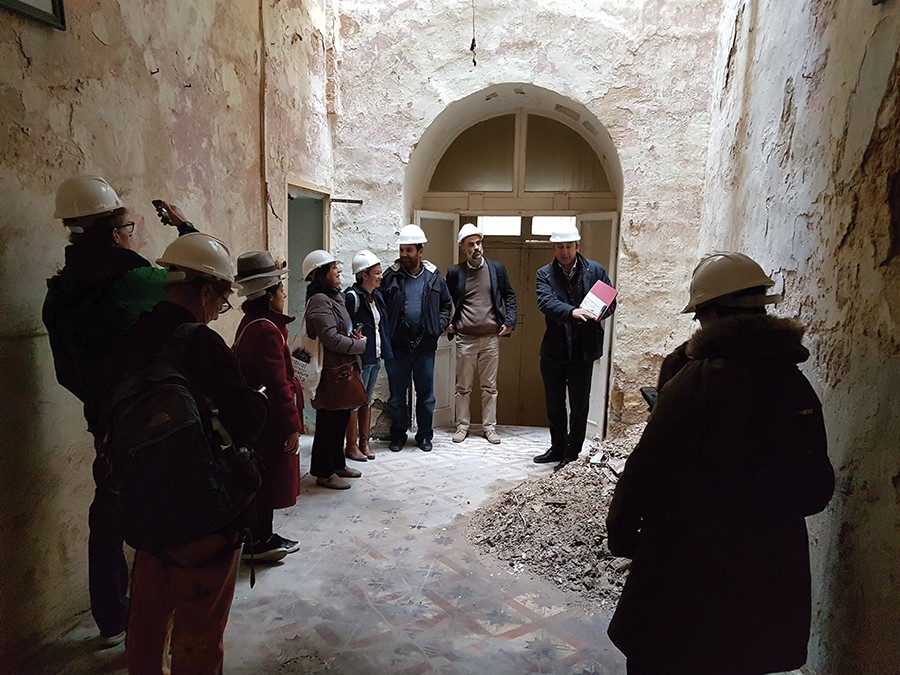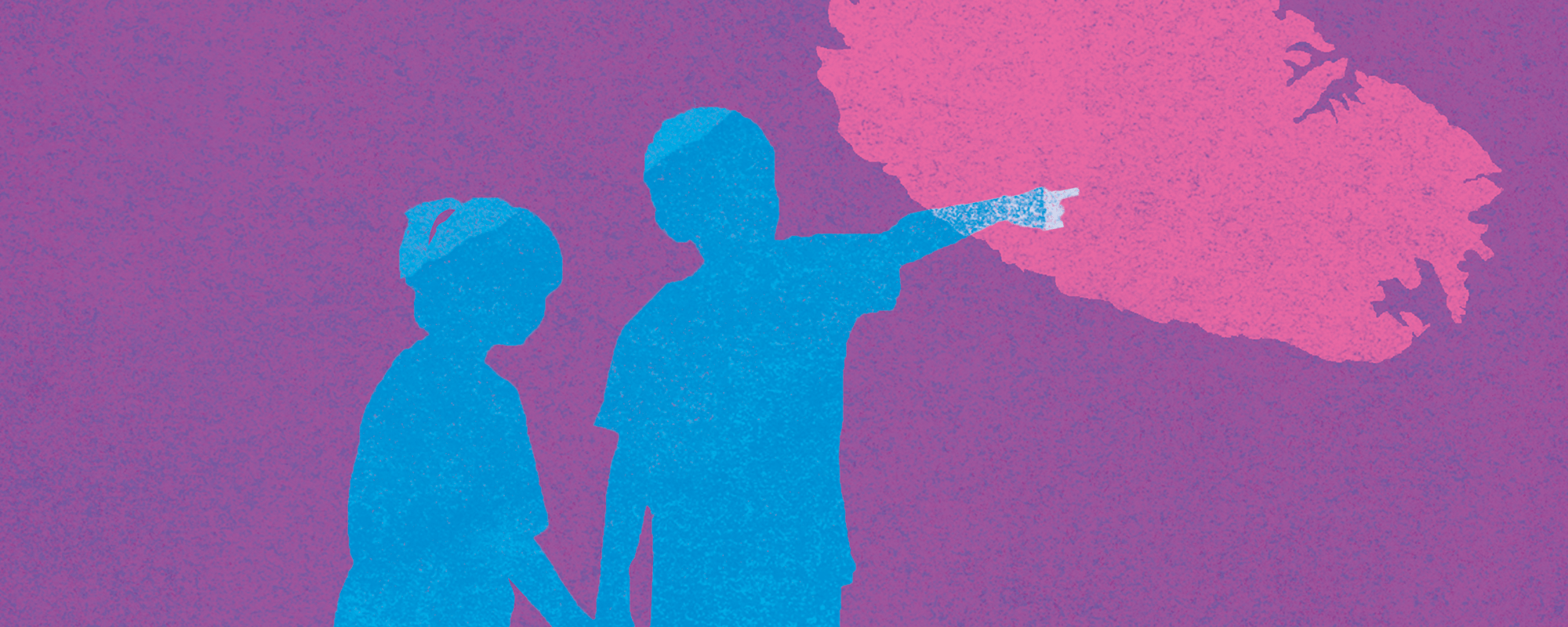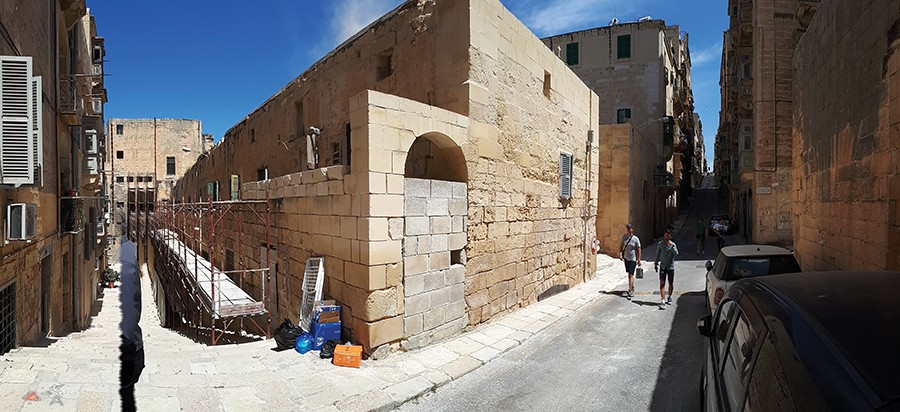Moving to Malta
Our childhood years are meant to help us develop our sense of identity, belonging, culture, and home. But what happens to those for whom childhood is dominated by moving to a new country with a new language, culture, and social norms? Prof. Carmel Cefai speaks to Becky Catrin Jones.

It’s a small world these days. Developments in technology and transport mean it’s much easier to pack your bags and head off for a fresh start in a foreign land. For many, the destination is Malta. As a beautiful island in the Mediterranean Sea with a booming economy, it is no surprise that it’s drawing the attention of bright sparks and aspiring families from Europe and beyond. In fact, Malta currently boasts the fastest growing EU population.
Of course, it’s not always through choice that you might find yourself leaving your homeland behind. Humanitarian crises and ongoing wars in North and sub-Saharan Africa and the Middle East have seen thousands set sail under the most treacherous conditions in search of safety. For this population, Malta is often the first port of call between the dangers of home and the promise of hope in Europe.
It seems strange to group these populations together, given the stark differences in the journeys that bring them to Malta and the life they seek here. But together, this influx of people has contributed to a sudden rise in interculturalism, where people from different backgrounds interact and influence one another. This is a reality all parties are having to adapt to.
Even in a fairytale scenario, childhood is challenging. Growing up when you’re far from home, look different to everyone around you, and don’t speak their language, makes the challenge reach a whole other level. Children’s wellbeing is an increasingly important and emotive topic to study in Malta, which is a signatory to the United Nations Convention on the Rights of the Child. A team of researchers from the Centre for Resilience and Socio-Emotional Health (University of Malta), set out to explore the situation. They questioned: How do you settle into a new home and identity when you are still trying to figure out who you are and where you are from?
Finding the voices
Children are often a silent group. When analysing the wellbeing or effect of migration on a population, they are usually spoken for by adults. For this study, however, Prof. Carmel Cefai and his team wanted the child’s voice as well. The scope of the study was ambitious; every single contactable, non-Maltese child living in Malta was invited to take part and share their experiences. But this was a challenge.

‘Identifying and obtaining access to foreign children from age zero to 18 was not easy… Some schools suffered from research fatigue and did not wish to participate; whilst translation of instruments and data and use of interpreters drained the limited budget we had for this project.’ Maltese children were contacted and invited to participate too. After all, they are as affected as anyone else when around one in ten of their schoolmates are not Maltese.
The study focused on four main areas; social interaction and inclusion, education, subjective wellbeing and resilience, and physical health and access to services. They covered the experiences of children up to 18 years of age, from various schools, who were either settled into their own family houses or still in open shetlers following a difficult journey to Malta. They also aimed for a balance in migrants’ nationalities; European, North American, African, Middle Eastern, or East Asian; as the experiences of each population are understandably different. Cefai and his team found that the experiences of migrant children in their everyday life are quite positive. In some areas, even more positive than those of Maltese children, with only 8% reporting difficulties in their psychological wellbeing compared to 10% in the native population. Overall, they found that migrant children feel safe, listened to, and cared for by the adults in their communities. Despite the language barriers, most feel like they have a support network, and enough friends though more often than not those friends are other foreign children, not Maltese.They are able to keep up at school, and generally do as well as their Maltese peers, with teachers reporting high levels of engagement.
Adapting to a new world
All is not rosy. Bullying in schools is quite common, though less frequent than that reported by native Maltese children. One in five migrant children also do not feel they have enough friends.
Younger children seem to be more included and engaged than secondary school ones, and in general females fared better in the study than male classmates. That said, age and gender weren’t the main influencers when it came to predicting how well the children engaged at school and in their communities. ‘The study suggests that there are different layers of reality, with the big picture hiding the socio-economic, psychological, and social difficulties encountered by a substantial minority,’ remarks Cefai.
Unsurprisingly, those who speak Maltese feel more engaged than those who don’t, and those who aren’t confident in English are in an even worse position. However, the factor producing the biggest differences between the overall wellbeing, health, and education of the children is their country of origin. ‘The health, wellbeing, and relative comfort enjoyed by many children of European economic migrants contrast sharply with the poverty, poor accommodation, psychological difficulties, learning difficulties, and experiences of discrimination of many children from Africa and the Middle East’, says Cefai. Western Europeans and American children scored highly over all criteria, whereas African and Middle Eastern children are far more likely to be lonely or suffering from social or economic difficulties.
They are more likely to be less proficient in English, which leads to difficulties in making friends with children from other cultures and which also contributes to problems in their education. Although they are generally nourished by their spiritual and religious communities, in all other areas these children report social and emotional difficulties and are also more likely to report facing prejudice and discrimination. Healthcare proved problematic; many parents and children worry that they are subjected to discrimination whilst using services, or do not have enough information to use them in the first place.
A land of opportunity
Despite the additional challenges that these particular migrant children face, the overriding feeling is one of acceptance and hope. Even children in open centres view Malta as a land of opportunity, even when some are in suboptimal housing and lack basic necessities. What children in open centres do not perceive is Malta as their home. Better living conditions in the community, more cultural sensitivity, and openness to interculturalism may help to reduce the feeling of ‘us’ and ‘them’.
So what do Maltese children think? Again, the overall conclusions show that children are open, tolerant, and welcoming of this dramatic and quick rise in multiculturalism that has happened. However, on closer inspection, it seems that there is still a way to go before we can truly call ourselves an open and accepting society.
Relatively few Maltese children have many foreign friends, preferring to spend time with native peers. This hesitation is stronger in children who aren’t from a mixed community, whereas children in independent schools and more exposed to foreign children seem more at ease with the idea that the future might be even more multinational and intercultural. As many as one in three Maltese children also report feeling unsafe in culturally diverse communities, and worry about potential negative consequences of these changes in the future. There also appears to be particular prejudice against children from Africa and the Middle East in contrast to children from Europe, the US, Canada, and Australia.
What has become clear is that both foreign and native children could do with some reassurance. So what do Cefai and his team suggest we can work on to help everyone embrace this new culturally diverse reality?
A united future
‘[We need] to address the needs of marginalised and vulnerable children, particularly those coming from Africa and the Middle East’, says Cefai. There’s also a lot both populations could learn from each other; caring for their environment, sharing cultures, or even adopting healthier lifestyles. By encouraging more open and judgement-free spaces to play, learn, and share, we’ll take away the ‘us’ and ‘them’ ideology from a young age and replace it with one of acceptance, curiosity, and openness to new ideas. This will help prevent the dangerous spiral of segregation and ghettoisation, seen all over Europe.
Cefai suggests a space for more positive role models for those migrant children thrown into a foreign culture that doesn’t seem to have space for them. Having teachers, healthcare workers, or even political representatives who have similar backgrounds will foster this inclusive nature, showing that everyone has a voice when it comes to working together to make this country a home for all.
There’s work to be done with Maltese children. ‘Whilst it is encouraging that the majority hold positive attitudes towards interculturalism, it is worrying that as they grow older children’s attitudes tend to become less positive,’ says Cefai. ‘It’s our responsibility to ensure that educators, community leaders, and parents of Maltese children are part of a national initiative to embrace interculturalism.’
Although overall a positive study, Cefai and team have shown we still have a way to go until every child in Malta feels safe, happy, and at home. And in this ever-changing and diverse environment, Malta has real potential to be an example to its neighbours on how a successful multicultural society can work on every level. These children are our future.
Openness: The case of the Valletta Design Cluster
Valletta should be a unique experience, open to all. This is Valletta 2018’s key vision for the bustling capital. A group of people focused on making this a reality is the Valletta Design Cluster team. Located at the Old Abattoir site in Valletta, the initiative is going to create a community space for cultural and creative practice. Words by Caldon Mercieca.
According to Anna Wicher from the PDR International Centre for Design and Research, design is ‘an approach to problem-solving that can be applied across the private and public sectors to drive innovation in products, services, society and even policy-making by putting people first.’ This people-centred approach to design is not just a theoretical framework, but a concrete method that engages people in a co-creative process.
By bringing together people active in the cultural and social spheres, we want to have a concrete and meaningful impact on Malta’s diverse communities. We aim to provide support for students, start-ups, and creative enterprises and give social groups the necessary tools to empower those with different interests who nonetheless share the common purpose of using creativity for the social good. We also want to provide a new networking space for everyone. From students, to cultural and creative professionals, to residents, budding businesses and civil society groups, everyone will be welcomed at the Valletta Design Cluster.
This philosophy of openness and diversity is one that has permeated every aspect of the project from the very beginning. Over the past three years, we have consulted with residents, students, schools, higher education institutions, artists, makers, and creatives to build the vision for the space. A range of public and independent organisations are also contributing to the project, providing both expertise and generous support.

Thanks to the support from the European Regional Development Fund, the physical space for the Cluster as well as the urban public spaces around it are currently undergoing serious regeneration. Once finished, the Cluster will have a range of facilities, which were decided on following consultation with potential users. It will include a makerspace, coworking spaces, studios, a food-space, several meeting rooms and conference facilities, an exhibition space, and a public roof garden. All of these facilities have benefitted from input contributed by various potential users, by residents, and by organisations that have been interacting regularly with the team working on the Valletta Design Cluster.
We believe that a community can only truly reach its potential when it opens itself up to collaborations which share a common goal. This does not mean turning a blind eye to the challenges faced by the community on a daily basis, or to the ever-evolving scenario that surrounds it, but rather cultivating a readiness to learn, an aptitude to develop networks built on trust, and a capacity to address problems with a practical, positive, can-do attitude.
One valuable experience we are developing with our community stakeholders is Design4DCity. This annual initiative, which the Valletta Design Cluster team started back in 2016, sees creatives, residents, and local authorities joining forces to rework and improve a public space. We worked with the Valletta community in 2016, and continued with the Birżebbuġa community in 2017. In 2018 we plan to work again in Birżebbuġa as well as in Siġġiewi, and will involve children and young people in our public space projects. Such initiatives are providing very important insights into the application of collaborative, co-creative approaches involving multiple stakeholders.
But the work of the Valletta Design Cluster is not restricted to the restoration or transformation of space. For the past three years, we have collaborated with the Malta Robotics Olympiad, teaming up with artistic curators and student organisations from the University of Malta (UM) to design and construct the pavilion for Valletta 2018. By the end of the project, participants had constructed a fully-recyclable 300 square meter pavilion and presented it to the public. This year we also supported SACES, the architecture students’ association at the UM, through a number of design and construction workshops. Branching out, we have done work with a number of creatives from various backgrounds in projects involving video-capture, artifact-curation, narrative development linked to cultural identities, and flexible use of available space through appropriately constructed spatial modules.
Several workshops have also been held where project stakeholders were fully involved in training sessions, with the aim of building skills in user-centred design, applied to specific contexts. This meant interacting with students, researchers, creatives, residents, and organisations in developing what the Cluster can offer. One tool used in this process is the construction of a user persona, where the characteristics, interests and concerns of the user are gathered through interaction with potential users of a service. Students from a number of faculties have also provided their input in this process through dedicated workshops at the UM.
They also stressed that the Cluster needed to serve as a catalyst for networking and for strengthening entrepreneurial skills for people working in the creative sector.
All of this has become possible thanks to continuous collaboration and international networks which have contributed their resources to our projects. To assist us in this, the Valletta 2018 Foundation has joined Design4Innovation, an Interreg Europe project bringing together eight European countries all working towards using design to benefit society.
While we have been on the receiving end of a lot of support, translating our philosophy of openness into practice involved an element of risk. During a series of tours that we organised on site for potential users of the Cluster, we had to be open to various views and perspectives about what the Cluster could be. Participants highlighted issues related to accessibility and affordability as key concerns. They also stressed that the Cluster needed to serve as a catalyst for networking and for strengthening entrepreneurial skills for people working in the creative sector. In some cases, we had to revisit some of our plans and open new discussions with the architects to made adjustments. On other occasions, we called people in again to discuss their ideas further and see how we could integrate their suggestions into our vision.
Although we speak of cultural and creative industries, we should realise that the average number of people working in any single company is two. Indeed, 40% of designers in Malta are actually freelancers. The challenge for the Valletta Design Cluster here is to ensure flexibility and adaptability both in the physical infrastructure as well as the management of the Cluster. In this way, we can make the facility relevant for our users’ current needs, as well as cater to future ones.
The next stage in understanding our community of potential users better is to work together on the creation of a Design Action Plan. The Design Action Plan will highlight concrete actions to be undertaken by the Cluster during the first three years of its operation. It will serve as the main reference tool to structure the Valletta Design Cluster’s interaction with its community of users, practitioners, enterprises, and beneficiaries. Based on this open process, the Valletta Design Cluster aims at establishing itself as a new community-driven platform for cultural and creative practice in Malta.
Author: Caldon Mercieca




